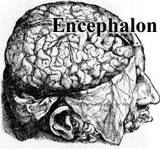I Am What I See
Schematic representation of the two streams of visual processing in
human cerebral cortex (taken from Goodale & Westwood, 2004).

There is no pattern, yet there is
The configuration lies within
--Single Gun Theory, I Am What I See
How does the brain categorize objects? Where is this information stored? Mostly, it's thought that the ventral stream of the visual system codes for object identity. Neuronal activity in the lateral prefrontal cortex has been related to stimulus categorizaton (Freedman et al., 2001). However, a newly published paper reports that after training in a categorization task, neurons in the parietal lobe of macaque monkeys became sensitive to category information.
Where We Store What We See
By Sara Goudarzi
Scientists have pinned down the region of the brain that encodes the category or meaning of visual information.
[NOTE: Wow! Really?? Can I write for LiveScience.com?]
The ability to take a piece of information through our senses, assign meaning to it and categorize it helps people make sense of the world around them and behave accordingly. Because of this, when a chair is seen by the eyes, it's deemed appropriate for sitting on.
"You're not born knowing about categories or things like chairs or tables or telephones," said lead author David Freedman, a postdoctoral research fellow in neurobiology at Harvard Medical School. "Instead those develop through learning." [NOTE: no kidding!!]
What I see is what I am
And I see before me an impoverished man
I am what I see
--ibid
. . .
"The activity didn't just encode what those visual patterns looked like," Freedman said. "Instead, the activity encoded what those patterns actually meant or what category those patterns belonged to."
 Of course, the reality of the experimental conditions was a lot more complicated than you're led to believe by the popular press (and by the first author's soundbyte). The "categories" were determined by direction of motion, and the specific parietal lobe region in question here is the lateral intraparietal (LIP) area. So it's not as if, suddenly, everything you knew about object recognition was wrong.
Of course, the reality of the experimental conditions was a lot more complicated than you're led to believe by the popular press (and by the first author's soundbyte). The "categories" were determined by direction of motion, and the specific parietal lobe region in question here is the lateral intraparietal (LIP) area. So it's not as if, suddenly, everything you knew about object recognition was wrong.David J. Freedman and John A. Assad. Experience-dependent representation of visual categories in parietal cortex.The Harvard press release is also guilty of duping the reader into thinking that parietal cortex is responsible for encoding the meaning of familiar visual images.
Nature advance online publication 27 August 2006.
Categorization is a process by which the brain assigns meaning to sensory stimuli. Through experience, we learn to group stimuli into categories, such as 'chair', 'table' and 'vehicle', which are critical for rapidly and appropriately selecting behavioural responses. Although much is known about the neural representation of simple visual stimulus features (for example, orientation, direction and colour), relatively little is known about how the brain learns and encodes the meaning of stimuli. We trained monkeys to classify 360° of visual motion directions into two discrete categories, and compared neuronal activity in the lateral intraparietal (LIP) and middle temporal (MT) areas, two interconnected brain regions known to be involved in visual motion processing. Here we show that neurons in LIP—an area known to be centrally involved in visuo-spatial attention, motor planning, and decision-making -— robustly reflect the category of motion direction as a result of learning. The activity of LIP neurons encoded directions of motion according to their category membership, and that encoding shifted after the monkeys were retrained to group the same stimuli into two new categories. In contrast, neurons in area MT were strongly direction selective but carried little, if any, explicit category information. This indicates that LIP might be an important nexus for the transformation of visual direction selectivity to more abstract representations that encode the behavioural relevance, or meaning, of stimuli.
Ball - two ball - motorwheel - bangle - teacup - cigarette ashtray - monkeydrum
--Single Gun Theory, I Am What I see
Free download here.

But everything in its right place [not]...
Everything in its place: Researchers identify brain cells used to categorize images
Findings shed light on the brain processes behind learning and memory
Boston, MA -- Socks in the sock drawer, shirts in the shirt drawer, the time-honored lessons of helping organize one's clothes learned in youth. But what parts of the brain are used to encode such categories as socks, shirts or any other item, and how does such learning take place?
New research from Harvard Medical School (HMS) investigators has identified an area of the brain where such memories are found. They report in the advanced online Nature that they have identified neurons that assist in categorizing visual stimuli. They found that the activity of neurons in a part of the brain called the parietal cortex encode the category, or meaning, of familiar visual images and that brain activity patterns changed dramatically as a result of learning. Their results suggest that categories are encoded by the activity of individual neurons (brain cells) and that the parietal cortex is a part of the brain circuitry that learns and recognizes the meaning of the things that we see.
. . .
Freedman is optimistic that research of this type will eventually contribute to a better understanding of neurological diseases and disorders. "Understanding how the brain learns, stores, recognizes and recalls visual information will help us overcome impairments to these functions caused from brain damage and diseases, including strokes, Alzheimer's disease, and schizophrenia," Freedman says.
[NOTE: And this rose-colored phrasing will help them get press coverage and grant funding.]
References
Freedman DJ, Riesenhuber M, Poggio T, Miller EK. (2001). Categorical representation of visual stimuli in the primate prefrontal cortex.
Science 291: 312-6.
Goodale MA, Westwood DA. (2004). An evolving view of duplex vision: separate but interacting cortical pathways for perception and action. Curr Opin Neurobiol. 14: 203-11.
Rosa MG, Tweedale R. (2005). Brain maps, great and small: lessons from comparative studies of primate visual cortical organization. Philos Trans R Soc Lond B Biol Sci. 360: 665-91.
Subscribe to Post Comments [Atom]

























